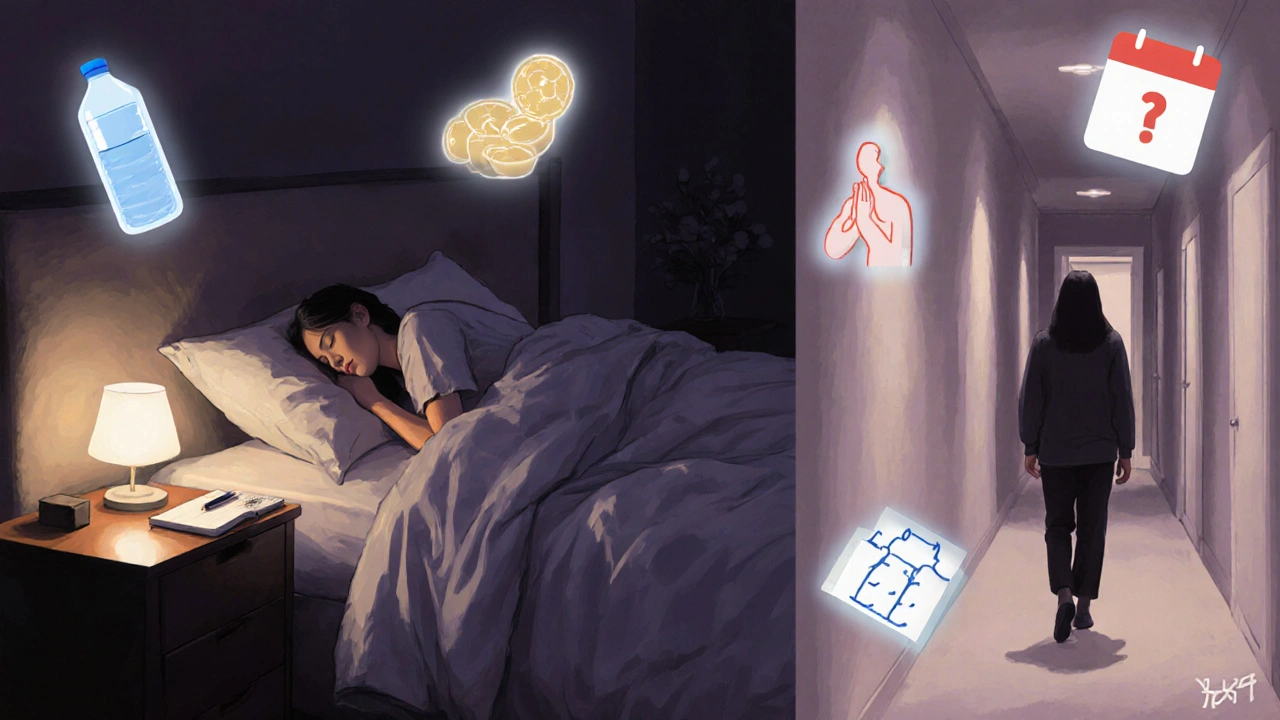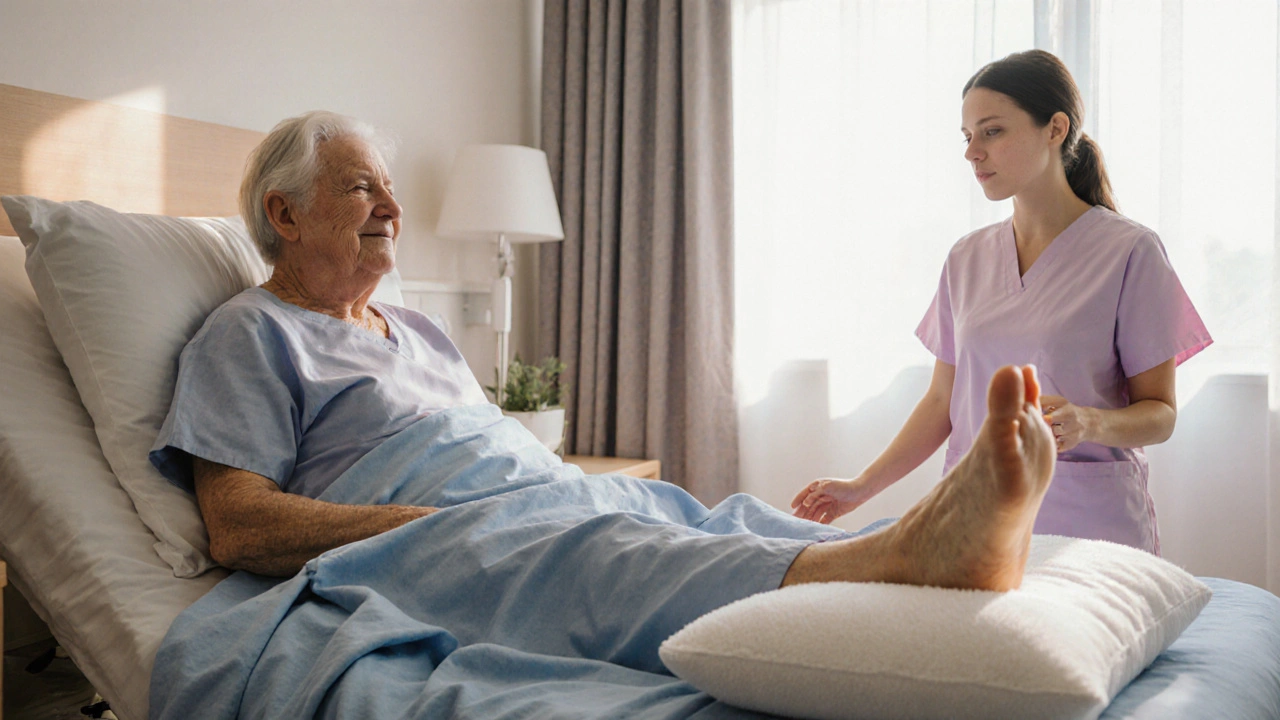Recovery Self-Care Tracker
Track your post-surgery recovery actions. Completing all tasks helps prevent complications and speeds healing.
Self‑care during recovery from anesthesia and surgery is the set of physical, emotional, and practical actions you take to support healing after an operation and after waking up from anesthesia. Most people focus on the surgery itself, but the days and weeks that follow are just as critical. Proper self‑care can reduce complications, speed up healing, and keep you feeling like yourself again.
Key Takeaways
- Start moving gently within the first 24‑48 hours to boost circulation.
- Hydrate and eat protein‑rich foods to repair tissue.
- Manage pain with prescribed meds and non‑drug techniques.
- Prioritise sleep, but adjust positions to protect incisions.
- Watch for warning signs and keep follow‑up appointments.
Understanding the Recovery Phase
When you emerge from the operating theatre, your body is still under the influence of anesthesia a drug‑induced state that blocks pain and awareness while the surgeon works. Even after you’re fully awake, the lingering effects can cause drowsiness, nausea, and reduced coordination. Recognising that your brain and muscles are still rebooting helps you set realistic expectations: you won’t feel 100% for several days, and that’s normal.
Nutrition & Hydration: Fuel for Healing
The body needs extra calories, protein, and fluids to rebuild tissue. Aim for at least 2liters of water per day unless your surgeon says otherwise. Incorporate easy‑to‑digest proteins like Greek yoghurt, scrambled eggs, or lean chicken. Adding a handful of berries gives antioxidants that combat inflammation. If you had bowel preparation, start with clear broths and gradually introduce soft foods.
self-care after surgery often begins at the kitchen table. A simple tip: set a reminder to sip water every hour and keep a protein snack on your bedside table.

Pain Management Without Over‑Reliance on Meds
Pain is a signal, not a punishment. Your doctor will prescribe analgesics, but over‑medicating can slow recovery and cause constipation. Use a scheduled approach: take the next dose before pain becomes severe, and combine with non‑pharmacologic methods.
First, try deep‑breathing exercises: inhale for four seconds, hold for two, exhale for six. This reduces stress hormones that amplify pain. Second, gentle surface heat (a warm pack for 15minutes) can relax muscles around the incision. Finally, a short walk-if cleared-releases endorphins, the body’s natural painkillers.
Gentle Mobility & Breathing Exercises
Staying in bed may feel safe, but immobility raises the risk of blood clots and lung issues. Post‑operative recovery benefits greatly from early, low‑impact movement that promotes circulation without straining the surgical site typically includes:
- Ankle pumps: rotate each foot up and down for 30 seconds every hour.
- Leg lifts: while lying flat, gently slide one leg a few inches, hold, then lower.
- Short hallway strolls: start with 5‑minute walks, increase by a minute each day.
Always follow your surgeon’s specific restrictions-some procedures require braces or limited weight‑bearing.
Sleep & Rest: Let Your Body Reset
Quality sleep accelerates tissue repair, regulates hormones, and sharpens the immune system. However, pain, bathroom trips, and the odd beep from monitors can disturb you.
Practical steps:
- Elevate the head of the bed slightly to reduce acid reflux, especially after anesthesia.
- Use a pillow to support the incision area, preventing pressure.
- Keep a dim night‑light on to avoid stubbing your toe when you need to get up.
- If you’re taking a sleep‑aid, use it only for the first few nights and under doctor guidance.

Mental & Emotional Care
The mental side of recovery is often overlooked. Feeling vulnerable, anxious, or sad after surgery is common. Mental health plays a crucial role in how quickly the body heals, because stress hormones can slow cellular repair can be supported in several ways.
Talk to a trusted friend or family member each day about how you’re feeling. Keep a short journal noting any pain spikes, mood changes, or achievements (like walking to the kitchen). If anxiety feels overwhelming, ask your doctor about short‑term counseling or mindfulness apps-many are free through the NHS.
Follow‑Up Appointments & Red‑Flag Symptoms
Even if you feel fine, the surgeon will schedule a follow‑up to check the incision, sutures, and overall progress. Bring a list of questions:
- Is it safe to resume my regular exercise routine?
- When can I stop taking pain medication?
- Do I need any additional physiotherapy?
Know the warning signs that require immediate attention:
- Fever above 38°C (100.4°F) that persists.
- Increasing redness, swelling, or pus around the incision.
- Sudden shortness of breath, chest pain, or severe calf pain-possible clot.
- Uncontrolled bleeding or drainage.
Prompt action can prevent minor issues from becoming major setbacks.
Self‑Care Checklist
| Area | Why It Matters | Simple Daily Action |
|---|---|---|
| Hydration | Supports blood flow and tissue repair | Drink 8‑10 glasses of water; keep a bottle at hand |
| Nutrition | Provides building blocks for healing | Include protein + fruit at each meal |
| Mobility | Prevents clots and lung complications | 30minutes of gentle walking or prescribed exercises |
| Pain Management | Reduces stress and allows movement | Take meds on schedule; add breathing or heat therapy |
| Sleep | Accelerates cellular repair | Maintain a regular bedtime; use pillows for support |
| Mental Health | Lowers cortisol, which can slow healing | Talk to a friend; journal 5minutes each evening |
Frequently Asked Questions
How soon can I start moving after surgery?
Most surgeons advise gentle ankle pumps and short leg lifts within the first 24hours. If you’re cleared for weight‑bearing, a brief hallway walk (5‑10minutes) can begin as soon as you feel stable.
Is it safe to take over‑the‑counter painkillers with my prescription?
Only if your doctor confirms there’s no interaction. NSAIDs (like ibuprofen) can affect clotting, which might be risky after certain surgeries.
What foods help reduce post‑operative swelling?
Foods rich in omega‑3 fatty acids-such as salmon, walnuts, and flaxseeds-have anti‑inflammatory properties. Pair them with leafy greens for extra antioxidants.
Can I shower soon after my operation?
If the incision is covered with a waterproof dressing, a gentle shower is usually fine after 24‑48hours. Avoid soaking the wound unless your surgeon says it’s okay.
When should I call my doctor during recovery?
Call immediately if you develop a fever over 38°C, notice increasing redness or drainage, experience sudden shortness of breath, or have uncontrolled bleeding.


Adam Martin
October 12, 2025 AT 16:12Wow, a self‑care checklist after surgery – because apparently we all need a puppy‑like reminder to drink water and wiggle our toes. First, let me commend the author for turning what should be common sense into a colorful spreadsheet of "must‑do" items that most of us already vaguely know. Sure, moving within 24‑48 hours sounds great until you’re still feeling like a groggy hamster after a marathon of anesthesia. Hydration? Of course, unless you've been told to stay NPO, then you’re basically forced to survive on saliva. Protein‑rich meals? Nothing says "healing" like a scrambled‑egg‑and‑yogurt combo that makes your stomach revolt. Mobility exercises? Yes, if you can muster the energy to sit up without wobbling like a jelly‑filled sack. Pain management without over‑medicating? That’s a fine line to walk when the prescription pad looks like a lottery ticket. Sleep, the elusive unicorn of the postoperative world, is constantly interrupted by bathroom trips and that ever‑present beeping from monitors that could be a ghost. And let’s not forget the emotional care – because nothing says "I’m fine" like journaling your feelings while you’re wrapped in a blanket of tubes and drains. The checklist also assumes you have quick access to a kitchen, a supportive family, and the cognitive bandwidth to remember to press a button every hour. And where is the part about dealing with the inevitable constipation that follows opioid use? Also, the advice to elevate the head of the bed for reflux is great, unless you’re already propped up on a mountain of pillows that turn your sleep into a precarious Jenga tower. The article mentions “watch for warning signs,” but the list reads like a medical thriller – fever, redness, shortness of breath – which could cause panic rather than calm. In summary, while the checklist is aesthetically pleasing, it could have been more useful if it acknowledged the reality of postoperative fog, the variability of surgeon instructions, and the sheer willpower required to follow every tiny directive. Still, kudos for the effort; at least now I have a printable poster to stare at while I wonder why my incision is still sore.
Ryan Torres
October 18, 2025 AT 11:10💊💀 Remember, the real agenda behind these "self‑care" guides is to keep you dependent on the pharma industry. They want you sipping water while they push the next pill. Wake up! 🙈
shashi Shekhar
October 24, 2025 AT 06:03Cool checklist, but honestly, most of us will just binge‑watch Netflix and hope the meds do the work. 🙄
Marcia Bailey
October 30, 2025 AT 00:56Hey everyone! 🌟 Just wanted to add that staying hydrated can be as simple as keeping a big water bottle by your bedside – set a timer on your phone and take a sip every 30 minutes. Also, gentle breathing exercises (inhale for 4, hold 2, exhale 6) really help with pain perception. If you feel sore, try a warm compress for 10‑15 minutes before your mobility routine – it loosens up the muscles. Lastly, don’t underestimate the power of a short daily journal; noting even tiny progress can boost morale. You’ve got this, and remember, progress isn’t always linear!
Hannah Tran
November 4, 2025 AT 19:50Building on Marcia’s great points, consider incorporating protein‑rich smoothies with Greek yogurt, almond butter, and a splash of oat milk – they’re easy on the stomach and provide the amino acids needed for tissue repair. Additionally, using a light‑weight resistance band for ankle pumps can add a bit of progressive overload without stressing the incision. For emotional support, a brief 5‑minute mindfulness session using apps like Headspace can lower cortisol levels, which in turn may accelerate healing. Finally, keep an eye on any unexpected drainage; a change in color or odor warrants immediate medical attention. Stay proactive and compassionate with yourself!
Crystle Imrie
November 10, 2025 AT 14:43Wow, that’s a lot of advice for a simple recovery.
Caley Ross
November 16, 2025 AT 09:36Honestly, I just focus on the basics: drink water, move a little, and try to get some decent sleep. The rest feels like extra fluff.
Bobby Hartono
November 22, 2025 AT 04:30i hear you caley but u know sometimes even the *tiny* steps can feel like climbing a mountain after an op especially when ur brain still foggy 😂 just keep that water bottle close and try to be kind 2 urself
George Frengos
November 27, 2025 AT 23:23Great article! I’d like to emphasize the importance of celebrating small victories – even a short hallway stroll is a win. Keep tracking your progress and stay positive.
Jonathan S
December 3, 2025 AT 18:16Honestly, celebrating “small victories” is just a way to keep you hooked on the gamified recovery process 😒. You’re told to log each sip of water and each step as if you’re earning points, but the truth is you’ll still end up feeling miserable if the underlying pain isn’t managed properly. Don’t let the checklist distract you from listening to your body. 🙄
Charles Markley
December 9, 2025 AT 13:10While the checklist is aesthetically pleasing, it lacks nuance. For instance, patients with comorbidities may have contraindications to liberal fluid intake, and the recommendation to “elevate the head of the bed” might exacerbate certain cardiac conditions. A one‑size‑fits‑all approach is academically irresponsible.